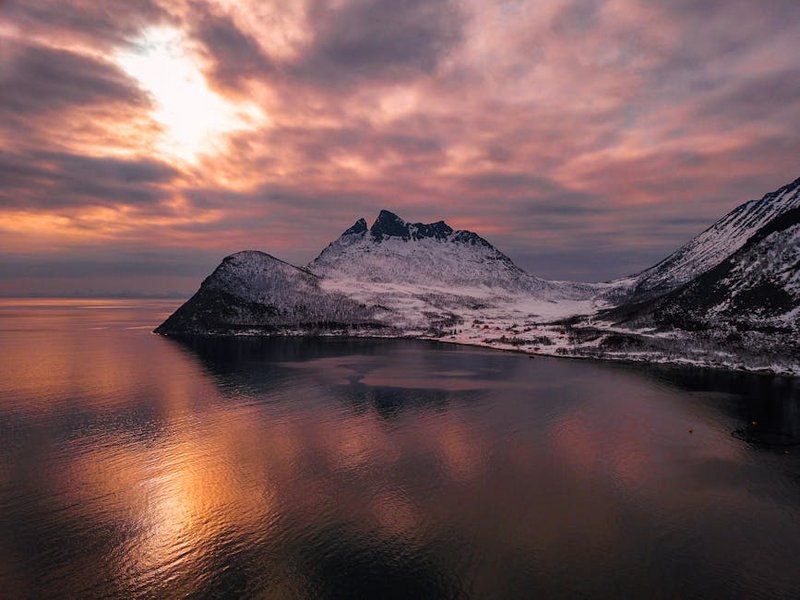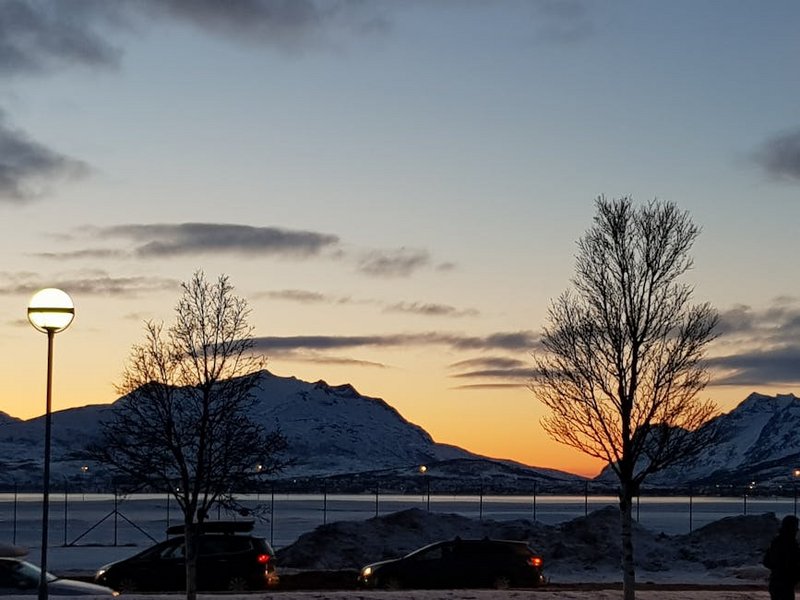Tromsø Northern Lights Hunt: Your Ultimate Arctic Aurora Adventure
Embarking on a Tromsø Northern Lights hunt places you in one of Earth’s prime locations for witnessing the aurora borealis, thanks to its position within the Arctic Circle. This Norwegian city combines optimal geomagnetic conditions with minimal light pollution, creating ideal circumstances for aurora viewing from September through March. You’ll find numerous tour operators offering guided expeditions that enhance your chances through expert knowledge of weather patterns and secluded vantage points. Beyond the celestial display, Tromsø delivers a full Arctic experience with dog sledding, fjord explorations, and Sami cultural encounters. Preparation involves understanding seasonal variations, dressing in thermal layers, and managing expectations since solar activity dictates visibility. This comprehensive guide covers everything from budget-friendly options to luxury packages, ensuring your aurora chase becomes a memorable journey rather than just a checklist item. With practical tips on photography, local customs, and alternative activities for cloudy nights, your Tromsø adventure promises both celestial wonders and cultural richness.
Essential Information – Tromsø Aurora Borealis
Tromsø serves as Norway’s Arctic capital, located approximately 350 kilometers north of the Arctic Circle at 69°N latitude. This positioning within the auroral oval means frequent and intense Northern Lights activity during the polar night season from late September to late March. The city’s coastal climate moderates temperatures compared to inland Arctic areas, with winter averages ranging from -5°C to -10°C (23°F to 14°F), though wind chill can make it feel colder. Historically, Tromsø has been a gateway for Arctic expeditions since the 19th century, with modern infrastructure supporting tourism while maintaining its fishing and university town character. The aurora borealis occurs when charged solar particles collide with atmospheric gases, creating green, purple, and pink displays that dance across the sky. Understanding these scientific and geographical factors helps you appreciate why Tromsø consistently ranks among top global destinations for aurora hunting, with visibility statistics showing active displays on clear nights approximately 60-70% of the season.
Understanding Aurora Borealis Phenomena
- Solar activity cycles peak every 11 years, influencing aurora intensity and frequency during your visit.
- KP index measurements from 0-9 determine visibility strength, with Tromsø typically requiring KP2-3 for visible displays.
- Moon phases significantly impact viewing conditions, with new moon periods offering darker skies for brighter aurora observations.
- Budget option: $50-$100 per night for hostels or Airbnb rooms, combined with $80 group tours using shared transportation and basic inclusions like hot beverages.
- Mid-range option: $150-$250 per night for hotel accommodations with breakfast, plus $150-$250 small-group tours featuring expert guides, thermal clothing, and photography assistance.
- Luxury option: $300-$500 per night for boutique hotels or glass igloos, paired with $300-$500 private tours including professional photography, gourmet meals, and flexible itineraries.
- Visit Tromsø Official Tourism Board
- Space Weather Prediction Center
Tromsø’s Geographic Advantages
Additionally, Tromsø’s archipelago location provides multiple microclimates that increase clearing opportunities during partially cloudy nights. The surrounding fjords and mountains create natural wind patterns that sometimes break up cloud cover, while coastal areas experience less extreme temperatures than inland regions. Furthermore, the Gulf Stream moderates winter conditions, making extended outdoor viewing more comfortable than in other Arctic locations. These geographic benefits combine with accessible wilderness areas just minutes from the city center, allowing tour operators to quickly adapt to changing weather conditions. Moreover, the extended polar night from November to January provides continuous darkness during prime viewing hours, maximizing potential observation windows.
Historical and Cultural Context
Arctic exploration heritage deeply influences Tromsø’s identity, with museums like Polaria and the Polar Museum documenting early expedition histories. Indigenous Sami culture remains vibrant through reindeer herding traditions, handicrafts, and storytelling that often incorporate Northern Lights mythology. Modern Tromsø balances this heritage with contemporary Scandinavian design, university research institutions, and a thriving food scene focused on local ingredients. Understanding these layers enriches your aurora experience beyond mere spectacle, connecting you to human stories intertwined with the Arctic environment.

Tromsø Northern Lights Hunt – Planning Your Trip
Organizing your Tromsø Northern Lights hunt requires strategic timing and resource allocation for optimal results. The core season runs from September 21 to March 21, with peak visibility typically occurring between October and February when darkness prevails for 18-24 hours daily. Tour prices range from $80-$200 for standard group excursions to $300-$500 for private photography-focused expeditions, with inclusions varying from thermal suits and hot drinks to professional images. You should book accommodations 3-4 months in advance for December-February visits, as hotels fill quickly during holiday periods. Physical preparation involves acclimating to cold weather through layered clothing systems and practicing nighttime photography settings if capturing the aurora. Contingency planning remains crucial since weather cancellations affect 30-40% of scheduled tours; building flexibility into your itinerary allows rescheduling without missing this Arctic spectacle. This Tromsø Northern Lights hunt planning approach balances anticipation with practical reality, ensuring you maximize opportunities while enjoying other winter activities during downtime.
Best Time to Visit Tromsø for Northern Lights
September and March shoulder seasons offer milder temperatures (-2°C to 3°C/28°F to 37°F) with reliable aurora activity and fewer tourists, though daylight hours increase reducing optimal viewing windows. October through February delivers maximum darkness with temperatures between -5°C and -12°C (23°F to 10°F), providing extended observation periods despite colder conditions. Specifically, January typically presents the clearest skies statistically, while December combines festive atmosphere with potential solar storms. However, November often brings heavier cloud cover and precipitation. Each month presents trade-offs between weather reliability, crowd levels, and daylight availability, making early or late season visits preferable for travelers prioritizing comfort over maximum darkness.
Budget Planning and Costs
Essential Preparation Checklist
Furthermore, assembling proper cold-weather gear proves critical for comfortable aurora viewing sessions lasting 3-5 hours. Thermal base layers, insulated waterproof boots rated to -40°C/-40°F, and rechargeable hand warmers prevent discomfort during stationary periods. Additionally, pack power banks for electronic devices since cold drains batteries rapidly, and download offline maps since wilderness areas lack reliable signal. Moreover, research tour operator cancellation policies—reputable companies offer free rescheduling or refunds for weather-related cancellations. Finally, secure travel insurance covering Arctic activities and potential flight delays due to winter weather systems common in Northern Norway.
Top Attractions and Activities
Beyond the celestial displays, Tromsø delivers diverse Arctic experiences that complement your aurora adventures. The Arctic Cathedral’s striking architecture creates spectacular photo opportunities during blue hour, while Fjellheisen cable car ascends 421 meters for panoramic city and fjord views. Dog sledding through snowy forests introduces you to husky culture, with tours ranging from 2-hour introductions to multi-day expeditions. Sami cultural experiences at camps outside the city offer reindeer feeding, traditional lavvu tent gatherings, and joik singing performances. Whale watching expeditions from November to January follow orca and humpback migrations in nearby fjords, while snowmobile tours access remote wilderness areas inaccessible by road. These activities fill daylight hours and provide cultural context, ensuring your Tromsø visit feels comprehensive even if aurora viewing conditions prove challenging during specific nights.
Must-See Highlights
Polaria Arctic experience center features interactive exhibits on climate science and marine life, with walk-through tunnels displaying bearded seals and Arctic fish species. The Polar Museum delves into hunting and expedition histories through artifacts from Roald Amundsen’s era, providing cultural depth to your Arctic understanding. Tromsø Botanic Garden showcases resilient polar flora despite snow cover, while the Mack Brewery offers tasting tours of the world’s northernmost beer production. These attractions operate year-round with extended winter hours, costing $15-$30 per admission, and typically require 1-2 hours for thorough exploration. Combining 2-3 highlights daily creates balanced itineraries that alternate between indoor and outdoor experiences.
Hidden Gems and Local Favorites
Telegrafbukta beach provides unexpected aurora viewing opportunities with minimal light pollution, accessible via 30-minute coastal walk from the city center. Local cafes like Risø and Smørtorget serve traditional Norwegian pastries and coffee, functioning as cozy warming stations between activities. Furthermore, the Tromsø Public Library’s architecture and quiet spaces offer respite from tourist crowds, while nearby ski trails at Tromsdalen provide free recreation with rental equipment available. Additionally, cultural events at the Nordnorsk Kunstmuseum feature Sami contemporary art, and verftet seafood market hosts pop-up dinners showcasing Arctic char and king crab. These insider spots deliver authentic experiences beyond standard tour itineraries.
Winter Photography Opportunities
Arctic light conditions create unique photographic challenges and rewards throughout the day. Blue hour lasting several hours during winter provides soft, directional light for landscape shots of snow-covered mountains and colorful harbors. Northern Lights photography requires tripods, wide-angle lenses (f/2.8 or faster), and manual settings around ISO 1600-3200 with 10-25 second exposures. Many tour operators include photography guidance, but practicing beforehand ensures you capture sharp images during brief aurora appearances. Additionally, daytime scenes of frozen waterfalls, ice-covered forests, and traditional fishing boats offer compelling subjects that document the full Arctic winter experience beyond just the nocturnal light shows.
Practical Travel Information
Navigating Tromsø’s logistics involves understanding transportation networks, accommodation options, and seasonal considerations. Tromsø Airport (TOS) receives direct flights from Oslo, London, and other European hubs, with airport express buses transferring passengers to the city center in 15 minutes for approximately $10. Within Tromsø, an efficient public bus system covers all major areas, while taxis and rental cars provide flexibility for independent exploration—though winter driving requires confidence handling snowy roads. Accommodation spans from budget hostels like Tromsø Activities Hostel to mid-range hotels such as Scandic Ishavshotel and luxury options like Clarion Hotel With. Booking.com and Airbnb list numerous properties, but December-January require reservations 4-6 months ahead due to high demand. Most hotels include breakfast, and many offer Northern Lights wake-up services, while apartment rentals provide kitchen facilities for self-catering. This practical foundation ensures comfortable Arctic exploration regardless of budget or travel style.
| Category | Options/Features | Price Range (USD) |
|---|---|---|
| Accommodation | Hostels with shared facilities, hotels with breakfast included, apartments with kitchenettes | $50-$500 nightly |
| Tours | Group bus expeditions, small van tours, private guides, photography workshops | $80-$500 per person |
| Dining | Food trucks, casual cafes, mid-range restaurants, fine dining with local ingredients | $15-$150 per meal |
| Activities | Dog sledding, whale watching, cable car, museum entries, Sami culture experiences | $30-$300 per activity |


